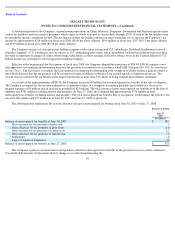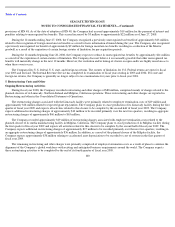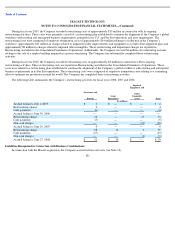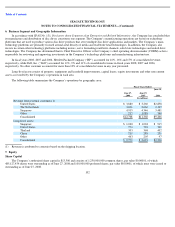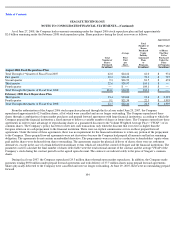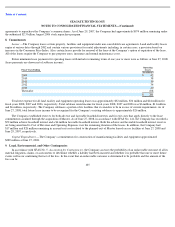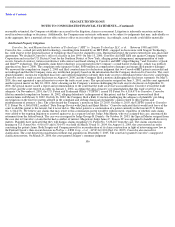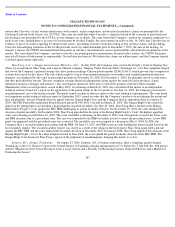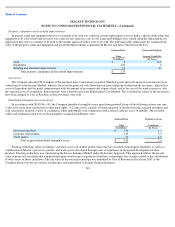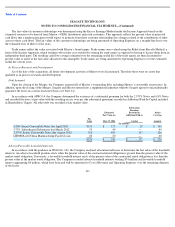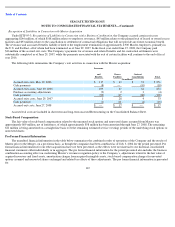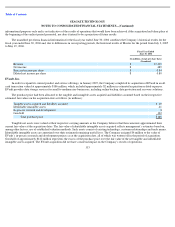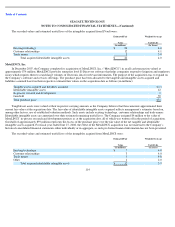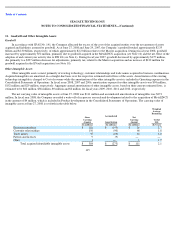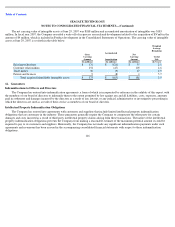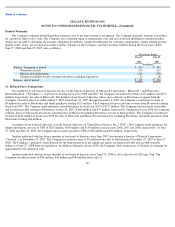Seagate 2007 Annual Report Download - page 108
Download and view the complete annual report
Please find page 108 of the 2007 Seagate annual report below. You can navigate through the pages in the report by either clicking on the pages listed below, or by using the keyword search tool below to find specific information within the annual report.
Table of Contents
SEAGATE TECHNOLOGY
NOTES TO CONSOLIDATED FINANCIAL STATEMENTS
—
(
Continued)
motion that Convolve’s fraud, tortious interference with contract, unfair competition, and breach of confidence claims are preempted by the
California Uniform Trade Secrets Act (CUTSA). The court also held that while Convolve’s claim for breach of the covenant of good faith and
fair dealing is not preempted by the CUTSA, no tort damages are available. The court denied the Company’
s motion for summary judgment on a
trade secret issue, finding there is an issue of fact that must be decided. Finally, the court entered an order on July 14, 2006, that Convolve has no
evidence to prove its claims regarding 10 alleged trade secrets, precluding Convolve from proceeding at trial on those claims, and precluding
Convolve from alleging violations of the 10 alleged trade secrets by either defendant prior to December 7, 2005, the date of the hearing. At
Seagate’s request, the USPTO determined that both patents in suit have substantial new issues of patentability and ordered reexamination of the
patents. The court denied the Company’s motion to stay the case pending patent reexamination. In initial office actions, the USPTO Examiner
rejected all claims of both patents as unpatentable. No trial date has been set. We believe the claims are without merit, and the Company intends
to defend against them vigorously.
Shao Tong, et al. v. Seagate International (Wuxi) Co., Ltd. In July 2002, the Company were sued in the People’s Court of Nanjing City,
China, by an individual, Shao Tong, and a private Chinese company, Nanjing Yisike Network Safety Technique Co., Ltd. The complaint alleged
that two of the Company’
s personal storage disc drive products infringe Chinese patent number ZL94111461.9, which prevents the corruption of
systems data stored on disc drives. The suit, which sought to stop us from manufacturing the two products and claimed immaterial monetary
damages, was dismissed by the court on procedural grounds on November 29, 2002. On December 3, 2002, the plaintiffs served us with notice
that they had refiled the lawsuit. The new complaint contains identical infringement claims against the same disc drive products, claims
immaterial monetary damages and attorney’s fees and requests injunctive relief and a recall of the products from the Chinese market.
Manufacture of the accused products ceased in May 2003. At a hearing on March 10, 2003, the court referred the matter to an independent
technical advisory board for a report on the application of the patent claims to the two products. On June 10, 2003, the Company presented its
non-infringement case to the technical panel. The panel issued a technical advisory report to the court finding no infringement. The court heard
oral arguments on the technical advisory report in September 2003, issued an order that the Company’s products do not infringe the patent and
rejected plaintiffs’ lawsuit. Plaintiffs filed an appeal with the Jiangsu High Court, and the Company filed its opposition brief on January 21,
2004. The PRC Patent Reexamination Board declared patent ZL94111461.9 invalid on March 28, 2004. The Jiangsu High Court stayed the
appeal on the infringement case pending a final judgment on patent invalidity. On June 22, 2004, Shao Tong filed a lawsuit in the Beijing
Intermediate People’s Court against the PRC PRB challenging its patent invalidity decision. On November 29, 2004, the court affirmed the
decision of patent invalidity. In December 2004, Shao Tong appealed the decision to the Beijing High People’s Court, the highest appellate
court, and a hearing was held June 22, 2005. The court scheduled a rehearing on December 8, 2005, and subsequently reversed the lower court
and PRB decisions due to a procedural error. The case was remanded to the PRB for further action to correct the procedural error. A new PRB
panel was appointed and the procedural error was corrected. The invalidity case was reargued at a hearing on May 9, 2006. In 2006, the
Company filed a second invalidity proceeding with the PRB. On June 14, 2007, the PRB issued an order holding the patent invalid based on the
first invalidity request. The second invalidity request was stayed as a result of the ruling on the first request. Shao Tong again filed a lawsuit
against the PRC PRB and the court affirmed the invalidity decision in December 2007. In January 2008, Shao Tong appealed this decision to the
Beijing High People’s Court. In a final judgment issued in June 2008, the court upheld the patent invalidity decision of the PRC PRB. The
Jiangsu High Court dismissed Shao Tong’s appeal of the judgment of noninfringment, bringing this matter to a close.
Siemens, AG v. Seagate Technology. On August 23, 2006, Siemens, AG, a German corporation, filed a complaint against Seagate
Technology in the U.S. District Court for the Central District of California alleging infringement of U.S. Patent No. 5,686,838 (the ‘838 patent)
entitled “Magnetoresistive Sensor Having at Least a Layer System and a Plurality of Measuring Contacts Disposed Thereon, and a Method of
Producing the Sensor.”
107




